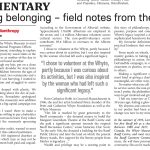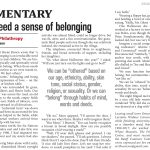The Ripple Effect – as published in Rocky Mountain Outlook, July 4, 2019
Truth be told, I was heading east on Wednesday June 19, 2013, in the direction of the airport. Rain ‘of biblical proportions’ pummelled the roof of the bus. The downpour was so hard and loud, it was hard to hear each other, so we silently watched as the windows grew steamy and puddles became small rivers.
Eight hours later we walked into my sister’s living room near Toronto and the television showed scenes of southern Alberta’s rivers raging. The province was on the brink of an emergency.
Fast forward to June 2019, exactly six years later. I am again in Toronto, sitting beside my sister in a darkened theater, watching ‘Come from Away’. The stage play is a re-enactment of a true story set in Gander, Newfoundland. During the ninety-minute performance, we learn how 38 planes carrying 7,000 passengers are re-routed to Canada, instead of their New York City destination. Time: September 11, 2001, the day four planes crashed in a series of terrorist attacks in the United States. Gander, a Canadian town of 9,000 was called to respond.
The actors are based on real people who slowly turn their numbness, fear and confusion into clarity, tempered with disbelief. Residents and passengers ask, “What shall I do? How can I help? I can’t watch the news any longer.”
“Ah-ha!” I thought. “That’s what happened during the flood.”
I called home Friday June 21 2013 and heard that the TransCanada Highway had closed. The rain had stopped, but the river was still rising. Volunteers were sandbagging rivers, yards and buildings. Reports from Calgary, Canmore and Exshaw were grim. Television cameras showed Canmore’s Cougar Creek carrying wooden decks and trampolines downstream while chewing the banks of neighbours’ homes, leaving them in a precarious position.
I felt a paralysing guilt mixed with relief. What could I do?
Later, Calgary Herald summarized that the flood beginning on June 20, resulted in 5 deaths, over 100,000 evacuations and damage that tallied in the billions. Still, as much as the flood’s devastation brought anguish, there was gratitude for the human decency that shone through the mud and destruction.
Exactly six years later June 2019, Romping musicians on stage turn the sadness and seriousness of a tense situation into optimism and faith in the future. Neighbours give bear hugs to strangers, public servants work hard, striking bus drivers leave the picket line and casseroles arrive.
Near the end, a lively party takes place at the Legion. All are invited to dance in a jig, share some screech and kiss the cod. Many join the joviality, but others stay home or walk away, unable to celebrate.
Belonging and building networks means having connections. Studies show that connectedness improves our well-being both collectively and personally. In turn, a strong social fabric assists in times of emergency, improves safety, adds meaning to life, and expands a person’s willingness to donate money or volunteer time.
In a StatsCan 2013 national survey, Newfoundland and Labrador ranked highest in their sense of belonging as a province. Alberta ranked lower as a province, but higher in our sense of belonging to Canada.
I knew I could help and remain grateful for being in a position where I connected with others who shared my beliefs. Together, we helped the Foundation channel $150,000 into ‘After the Flood’ projects.
Helping, giving, and connecting with others is simultaneously simple and complicated. It is not a trivial matter and might be a national priority. Personal circumstance determines age, experience, ability, faith, family, cultural beliefs and how we choose ‘to belong’. Times change. People move. Rivers rise. Not everyone wants to ‘kiss the fish’. Kindness helps.





